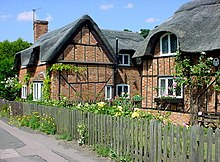Ampthill
Coordinates: 52 ° 2 ′ N , 0 ° 29 ′ W
Ampthill is a small town in Bedfordshire , England and lies between Bedford and Luton . The city has about 6000 inhabitants. It is administered by the Central Bedfordshire Council. Ampthill has had a weekly market every Thursday for centuries.
history
The name "Ampthill" comes from Anglo-Saxon . The first settlement in this area was "Aemethyll", which literally means "anthill". The Domesday Book states that the governor from 1086 was Nigel de la Vast. In 1242 the city received from King Heinrich III. the right to always have a market on Thursdays. This tradition continues into the 21st century. At the beginning of the 15th century, John Cornewall, 1st Baron Fanhope acquired extensive land in the area and had Ampthill Castle built. In the 16th century, King Henry VIII regularly visited the castle when his first wife Catherine of Aragón lived there from 1531 to 1533 . The castle was later demolished so that apart from a few fish ponds, no remains have been preserved.
St. Andrew's Church of England
The Church of St. Andrew goes back to the time between Contemporary English Architecture and Perpendicular Style Architecture. The church has a total of eight bells . By 1981 there were only six, the other two were added later. There is also a monument to Richard Nicolls (1624–1672), who was born in Ampthill. He was one of the commanders of the expedition that captured Nieuw Amsterdam . The city was later renamed New York and Richard Nicolls became the city's first British governor .
The Houghton House
The Houghton House was built by Mary Sidney and Sir Philip Sidney in 1621 . This building was the inspiration for "House Beautiful" in John Bunyan's The Pilgrim's Progress in 1675 . Bunyan's work is based on his travels between Bedford and Luton . The steep slope of Ampthill was the model for the "Hill of Difficulty" (German: Mountain of Difficulty ). Houghton House fell into ruin after the roof was removed in 1794.
style
John Fitzpatrick became the "Lord Ossory of Ampthill Park" in the 1780s. He started a campaign to improve the city center. He had the still existing market square , a water pump and a tower clock built. Fitzpatrick was also responsible for a memorial cross for Catherine of Aragón. It bears an inscription by Horace Walpole .
After the death of Lord Ossory in 1818, Ampthill became the seat of "Baron Holland". During his time, the Holland House in Kensington became a well-known meeting place for intellectuals .
Sir Albert Richardson , a 20th century British architect, lived in Ampthill from 1919 to 1964. During this time he shaped the architecture of the city.
Web links
- City information page
- City website
- Ampthill Town Council website
- Ampthill City Forum
- The history of the city
- St. Andrew's Church of England
Individual evidence
- ^ Who Was Who in America, Historical Volume, 1607-1896 . Marquis Who's Who, Chicago 1963.

